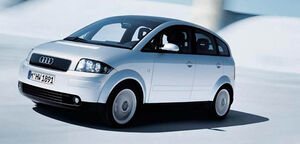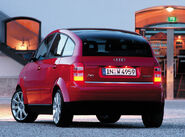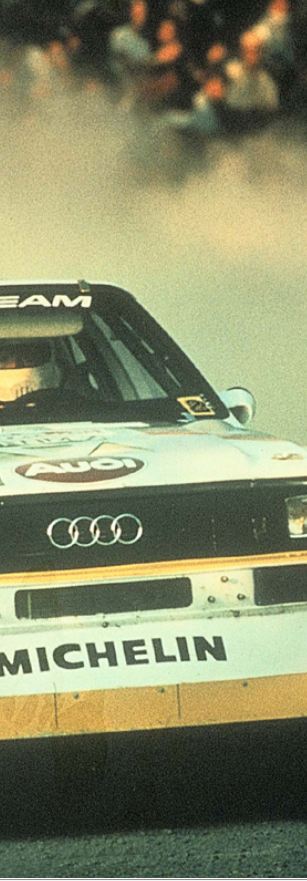
| |
| Audi A2 | |
|---|---|
| Audi | |
| aka | Audi A2 |
| Production | 1999-2005; circa 200,000 produced |
| Class | Compact |
| Body Style | 5-door hatchback |
| Length | {{{length - type here}}} |
| Width | {{{Width - type here}}} |
| Height | {{{Height - type here}}} |
| Wheelbase | {{{wheelbase - type here}}} |
| Weight | 895 kg (dry) |
| Transmission | 5-speed manual 6-speed manual 5-speed semi-automatic |
| Engine | 1.2 litre 3-cylinder turbodiesel 1.4 litre 4-cylinder turbodiesel 1.4 litre 4-cylinder petrol 1.6 litre 4-cylinder FSI |
| Power | 1.2 TDi - 60 bhp 1.4 TDi - 75 bhp or 90 bhp 1.4 petrol - 75 bhp 1.6 FSI - 110 bhp |
| Similar | Mercedes A-Class Mini Cooper |
| Designer | Luc Donckerwolke, Derek Jenkins |
The Audi A2 marked a departure from the normal for the German company. Produced from 1999 to 2005 at the company's Neckarslum plant, the all-aluminium hatchback was designed to sit below the Audi A3 at the bottom of the range. The styling was very advanced - it was based upon the Al-2 concept car - along with the build - Audi was the first to incorporate lightweight aluminium into mass-production. However, the car was not particularly successful, due to its high price and slightly odd styling, and Audi reportedly sold only 200,000 examples over its six-year production run.
Construction[]
ASF - Audi Space Frame[]
Audi's ASF has been developed in 1994 for use with the Audi A8, and the company decided that for its new smallest car, the technology would make a comeback. But there was a problem - the costs incurred by mass production using the expensive aluminium as a raw material. Whereas the A8 was in production of only 15,000 examples per year, Audi was chasing 60,000 for the A2, which called for a very sound structure.
Audi believed that the weight benefit gained by the use of aluminium was great enough to persevere - in fact, the aluminium construction was almost 40% lighter than the equivalent built with steel. The A2's ASF has been developed so that the panels were bonded to the bare frame, thus giving each panel a load-bearing effect, increasing the overall rigidity of the car. The aluminium production technique allowed each panel, or each piece of a single panel, to be tailored to meet its individual purpose, and in fact the whole roof varied dramatically from front to rear in terms of thickness, despite remaining as a single panel. Another reason for opting for aluminium was the ease of recycling it - no difference to that of your soda can - a fact which fitted in to Audi's aim of making the A2 exceedingly economical.
The Form[]
The distinctive design of the A2 makes for a very interesting automobile - and while the styling did not sell many cars, it set the tone for Audis today. The ASF incorporated all the panels (apart from the opening doors and hatch) into its structure, so that they could not be opened - this included the bonnet. Not having to worry about the practicalities of shut-lines and bonnet opening mechanisms, the designers could concentrate on creating a lithe, aerodynamic form, the product of which was an exceedingly low cd of 0.28 - ahead of its competition by a mile. The rear featured a fully glazed hatch, stretching from above the rear headrests right down to the shoulder line, giving the boot a large access but also letting lots of light into the cabin.
Since the bonnet did not open on hinges, a small flap was created at the front where the 'grill' was. This housed all the necessary ancillaries such as oil dipstick and windscreen fluid. The owner could access the engine by opening two locking bolts and removing the bonnet . Named the 'Serviceklappe', the flap was meant to aid maintenance of the car and prevent incorrect fluids from being changed. The design of the Serviceklappe changed frequently during the A2's production run - changing from gloss black on the early models to matt black on special editions. Final models, from 2004, featured flaps with grill slats.
Economy[]
The light weight of the aluminium structure allowed the A2 to achieve exceptionally good mileage - the A2 1.2 TDi currently holds the title as Norway's most economical car, with around 100mpg being achieved by a group of testers. In normal conditions, it is not impossible to achieve high-sixties in terms of miles-per-gallon.
To cash in on the economy image of the 'greenest' car in the range, Audi unveiled a special Euro-only (only sold in continental Europe - Britain didn't get any) version called the 3L - so named as it would only use three litres of fuel per 100 kilometer. The 3L featured flush glass to improve the aerodynamics and thus reduce drag, along with lighter suspension components, smaller alloy wheels and low-drag tyres. The block of the engine is also made from aluminium. The car cost more than the standard A2, and stories circulated of drivers experiencing grip loss and accidents caused by the narrower tyres in wet weather.
Legacy[]
The A2 was certainly ahead of its time, not just in respect to construction and economy, but also in class. The A2, although not being particularly successful itself, launched the premium compact market, ruled today by the Mini Cooper and Mercedes-Benz A-Class, and who's to say that if the A2 was launched later than it was, that it wouldn't be as successful as the Mini?
The use of aluminium as a construction material for cars was also proven by the A2, and the technology is used nowadays by numerous car manufacturers, including Audi and Jaguar. Certain practices used by Audi in the car's manufacture are used today by the aerospace industry, and feature heavily in modern passenger aircraft.
Audi have not denied the prospect of an A2 replacement in the near future to lock horns with the Mini Cooper. The mooted name of the A1 suggests that the car would be smaller than the A2, but would almost definitely draw upon the knowledge gleaned from the project.
Photos[]
See also[]

